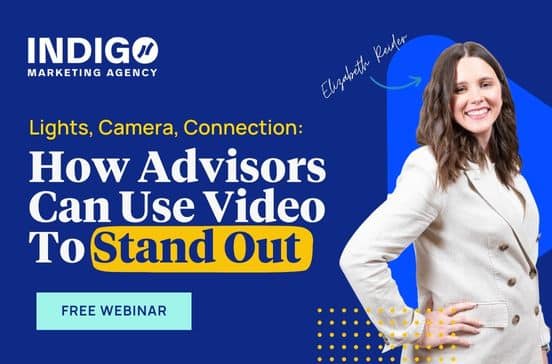5 Steps to an Effective Lead Magnet for Financial Advisors

As a financial advisor, you already know that one of your key goals is to attract and retain clients.
The question is HOW?
One highly effective tool that can help you rake in more A+ clients is a lead magnet. A lead magnet is a valuable piece of content or resource offered to potential clients in exchange for their contact information.
The idea is simple: provide something of value that entices your prospects to share their details, allowing you to nurture the relationship and convert them into paying clients over time.
In this quick 5-minute video, I break down the 5 essential steps for creating a powerful lead magnet for your financial advisory practice, plus some best practices to keep in mind.
Step 1: Define Your Target Audience
Before you start creating a lead magnet, it’s crucial to have a deep understanding of your target audience. Knowing who you want to attract helps you create content that resonates with them. Ask yourself the following questions:
- Are you targeting young professionals looking to learn about investing?
- Are your ideal clients’ families seeking guidance on college savings?
- Or are you trying to reach established business owners looking for retirement advice?
Each audience has unique needs and pain points, so your lead magnet should be specific enough to address those pain points and encourage your target audience to take action. The more tailored your content is to a particular demographic or niche, the more effective it will be in attracting qualified leads.
Step 2: Choose the Right Content Format
The format of your lead magnet can significantly impact its effectiveness. Financial advisors have several options, including:
- E-books or whitepapers: These in-depth guides on specific financial topics can provide valuable information to your audience.
- Checklists or worksheets: Maybe your prospects are drawn to practical tools that help them assess their financial situations.
- Infographics: Visual representations of complex financial concepts or market trends can simplify information for your audience.
- Calculators: Prospects appreciate helpful interactive tools like budget or retirement planning calculators that offer personalized insights.
Choosing the right format depends on your audience’s preferences and how they like to consume content. (Did you know that consumers increasingly prefer video content over written content?) For example, if your target audience prefers quick, actionable insights, a checklist or worksheet may be more effective than a lengthy e-book. Also, consider your strengths and resources as an advisor when selecting the format. Choose something you can create effectively and that will provide maximum value to your audience.
Step 3: Choose a High-Value Topic
The success of your lead magnet hinges on its perceived value by your prospects. If the topic isn’t engaging, relevant, or valuable enough, potential clients won’t feel compelled to provide their contact information in exchange for it. So make sure that your lead magnet offers unique insights, actionable advice, and practical solutions to your audience’s specific problems.
Let’s take a look at some examples of high-value topics versus less effective ones:
- Good Topics: Relevant, specific, and problem-solving.
- “The Ultimate Guide to Minimizing Your Taxes for Business Owners With Fewer Than 25 Employees”
- “Are You on Track to Financial Independence As a Physician? Use Our Interactive Calculator to Find Out!”
- “Post-Divorce Financial Checklist for Newly Single Women”
- Not-so-Great Topics: Too broad, generic, or overly sales-oriented.
- “Retirement Planning 101”
- “The Complete Guide to Financial Planning”
- “How to Invest”
While these broader topics may still be valuable, they are less likely to capture attention because they lack the specificity needed to address a particular group’s needs. Instead of generalizing, focus on niche topics that speak directly to your target audience.
Webinar Alert! Looking for more info on how to attract your ideal clients by honing in on a specialty? Check out our free webinar Your Riches Are in Niches!
Step 4: Create a Professional Design
A lead magnet is not just about content—it’s also about presentation. Even if your insights are life-changing, a poorly designed lead magnet reflects badly on you as an advisor. A polished, professional design establishes credibility and leaves a positive impression on potential clients.
If design is not your strong suit, don’t worry. Consider hiring a freelance graphic designer or using online design tools to create visually appealing content. You want your lead magnet to include your branding elements, such as your logo and color scheme, for consistency and professionalism.
Step 5: Implement a High-Quality Lead-Capture System
Once your lead magnet is ready, you need a way to deliver it to your prospects and capture their contact information. This typically involves creating a landing page where prospects can download your lead magnet after submitting their details. To maximize conversions, keep the sign-up process simple—only ask for essential information like name and email address. Too many form fields or a complex process can deter prospects from completing the form.
After capturing the lead’s information, use email marketing or CRM software to manage and nurture those leads. Automated follow-up emails can help you stay top-of-mind with your prospects and move them further down the sales funnel.
Bonus Tip: Amplify Your Lead Magnet With Facebook Ads
Looking for an efficient way to distribute your lead magnet? Consider using Facebook Ads. With Facebook’s advanced targeting capabilities, you can reach precisely the right audience based on demographics, interests, and behaviors. Facebook’s ad platform also lets you set a budget, monitor performance in real-time, and adjust your campaigns as needed.
Combining a high-quality lead magnet with the reach of Facebook Ads can significantly boost your visibility and generate more of those qualified leads.
Pros and Cons of Lead Magnets
Lead magnets are a type of gated content, which means people must share their contact info to get access. This can help you gather valuable leads, but it might also limit your content’s reach and lead to more people dropping off. Some might be reluctant to give their details and could abandon the download. However, when used right, lead magnets can boost your marketing strategy and help you qualify leads before you spend time reaching out.
Need Help Creating a Lead Magnet?
Are you ready to create a lead magnet but not sure where to start? We’re here to help. The Indigo Marketing Agency team can assist with everything from brainstorming high-value topics to writing and designing the content.
In fact, our Total Marketing Package Growth tier offers a lead magnet funnel including a custom landing page, a downloadable lead magnet, and a conversion email campaign.
We know what works, so let us do the work for you!
To get started, schedule a free strategy call with one of our marketing experts today!

Schedule Your Free Marketing Strategy Call Today
Check Out Our Related Video Content
Whether you’re a beginner or looking to improve your existing video marketing efforts, this webinar is designed to provide actionable insights and practical tips to make your videos a success.
At Indigo Marketing Agency, we help financial advisors embrace the evolving marketing landscape by utilizing custom video content. Read on for three reasons why you should incorporate video into your marketing strategy and how the Indigo team can help.
Connecting with your clients is of the utmost importance. But it can be really challenging in today’s digital age with all the noise. How are you supposed to stand out from the crowd?
FAQs
A lead magnet is a valuable piece of content or resource offered to potential clients in exchange for their contact information. For financial advisors, lead magnets are important because they help attract and engage prospects, allowing advisors to nurture relationships and convert leads into paying clients over time. By providing something of value, you can build trust and establish yourself as an authority in the financial industry.
The right content format for your lead magnet depends on your target audience’s preferences and how they like to consume information. Options include e-books, whitepapers, checklists, worksheets, infographics, and calculators. Consider your audience’s needs and your strengths as an advisor when selecting a format. For example, if your audience prefers quick, actionable insights, a checklist may be more effective than a lengthy e-book.
High-value topics for lead magnets are specific, relevant, and solve a particular problem for your target audience. Examples include:
- “The Ultimate Guide to Minimizing Your Taxes for Business Owners With Fewer Than 25 Employees”
- “Are You on Track to Financial Independence As a Physician? Use Our Interactive Calculator to Find Out!”
- “Post-Divorce Financial Checklist for Newly Single Women”
These topics are tailored to specific demographics and address their unique financial concerns, making them more likely to attract qualified leads.
Design is crucial when creating a lead magnet because it reflects your professionalism and credibility. A polished, professional design leaves a positive impression on potential clients and enhances the perceived value of the content. If design is not your strong suit, consider hiring a freelance graphic designer or using online design tools to ensure your lead magnet is visually appealing and consistent with your brand.
A lead-capture system is a method used to collect contact information from prospects in exchange for access to your lead magnet. Typically, this involves creating a landing page where prospects can download the lead magnet after submitting their details, such as their name and email address. To maximize conversions, keep the sign-up process simple and use email marketing or CRM software to manage and nurture the leads, guiding them further down the sales funnel.




































